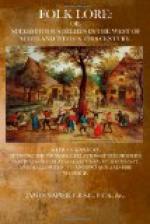When a number of boys or girls were trying to find out a puzzle or guess put to them, and which they failed to unravel or answer, and when they were searching for something which had been hidden from them, and which they could not discover, the usual method of acknowledging that they were outwitted was by spitting on the ground; in the language of the day, they would be requested to “spit and gie’t o’er,” that is, own that they were beaten. The propounder of the puzzle, or the party who had hidden the object, was then bound to disclose the matter.
When two boys quarrelled, and one wet the other boy’s buttons with his spittle, this was a challenge to fight or be dubbed a coward.
Mahomet held that bad dreams were from the devil, and advised the dreamers to seek protection by addressing a short prayer to God, and then spitting three times over their left shoulder. He further counselled them to tell the dream to no one, and by following these instructions no harm, such as the dreams had foreshadowed, would befall them.
In the case of a person bitten by a dog, a few hairs taken from the dog’s tail, and placed upon the wound either upon or under a poultice, was regarded as a protection from evil consequences, such as hydrophobia. I know of an instance in which this remedy was applied so lately as 1876. This practice is unmistakeably the origin of the toper’s proverb when suffering from headache in the morning,
“Take a hair of the dog that bit you.”
I will not enter into the subject of faith in the influence of relics. Such beliefs existed in Scotland in my young days, and it is almost unnecessary to say that belief in such things is older than history. In my youth there was also a belief in the virtue of precious stones, which added a value to them beyond their real value as ornaments. An investigation into this matter would tend to throw much light upon many ancient practices and beliefs, as each stone had its own symbolic meaning, and its own peculiar influence for imparting good and protecting from evil and from sickness, its fortunate possessor. Probably John’s description of heaven with its windows of agate, its doors of pearls or carbuncles, its foundations of amethyst, with sapphires blue, and sardines clear and red, had relation to the popular beliefs of the time. I have seen at Mill More, Killin, stones which are reported to have been used by St. Fillan for curing all sorts of diseases; and there are not a few persons at the present day who wear certain polished stones about their persons as a protective influence against certain diseases.
The ancient Jews had a superstitious idea respecting precious stones, which gave that strong desire for their possession, which is still characteristic of the race.
The Diamond was an antidote to Satanic temptation.
Ruby made the possessor brave.
Topaz preserved the bearer against being poisoned.




